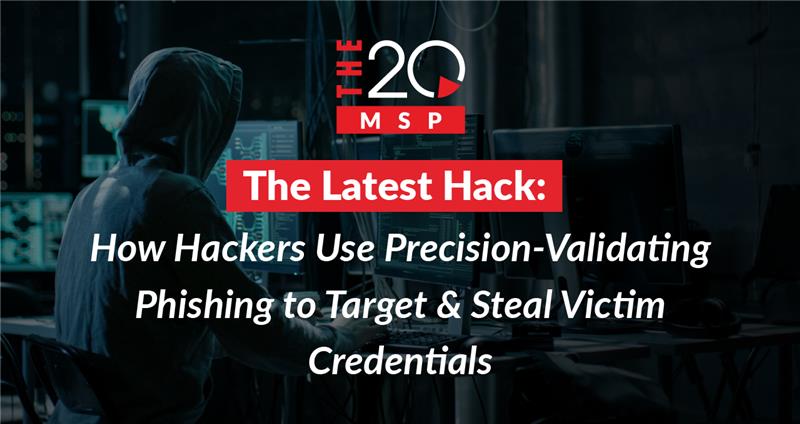
The Latest Hack: How Hackers Use Precision-Validating Phishing to Target and Steal Victim Credentials
Phishing just got a whole lot more dangerous, folks. This time, hackers have figured out how to connect with their perfect match. How? Through a new trick called precision-validating phishing. It may not sound sexy, but trust us – this tactic is like Tinder gone very, very wrong.
Let’s talk about it.
The Hack:
Coined by Cofense, precision-validating phishing is phishing, but with a creepy layer of sophistication. It starts like the countless phishing scams that came before it: you get an email with a link to a malicious website. But here’s the twist: behind the scenes, the hackers are checking how active – and how valuable – your email is based on things like how often you open messages, respond to businesses, or have it linked to work, banking, or subscriptions.
The hackers then cross-reference your address with data they’ve compiled from breaches, public records, and even email engagement tracking. If they find your email attractive, they proceed with the scam. It’s like they’re swiping through a dating app; the hackers are trolling for their next high-value victim.
Based on what they find, one of two things happens:
You’re a match:
If your email checks out – active, legitimate, and potentially profitable – congrats (but actually, yikes), you’re a match! The precision-validating phishing was a success, and the hacker website will now show you a fake login screen designed to steal your credentials.
You’re not:
If you don’t meet the mark, you’ll be shown an error message and redirected to a harmless site like Wikipedia, and the phishing scam stops there. For once, being ghosted is a win, but once again there’s a catch. While not getting scammed is great, this redirection helps throw off security teams and makes the phishing attempt harder to trace.
By weeding out low-value targets and focusing only on prime candidates, hackers are running smarter scams – and they’re getting harder to spot.
Who the Hackers Are Targeting (and Why)
Precision-validating phishing is far from the “spray-and-pray” method that many other phishing schemes implement. It’s targeted.
Hackers are going after people with real, valuable credentials – think business users, corporate accounts, IT admins, or anyone with access to sensitive data or systems.
Even if you don’t think of yourself as a “high-value target,” your credentials might be a steppingstone to something bigger. That’s because your work email is part of your business’s attack surface – any part of your organization that a hacker can use to enter. Once inside an account, hackers have many ways of navigating through a secure environment to find important, sensitive data, and to compromise even more accounts.
Why Is It So Effective?
Precision-validating phishing changes the game for a few key reasons:
- Harder to catch – by redirecting low-value targets, attackers throw off security teams and avoid triggering alerts.
- Smarter filtering – Targeting only high-value, active accounts means a better chance of success with each attempt.
- Longer campaign lifespan – Fewer alarms mean phishing sites stay live longer, increasing the number of potential victims.
- Better resale value – Verified, active credentials are far more valuable on the dark web and fetch a higher price.
What Can You Do?
The best defense against precision-validating phishing is sticking to proven phishing prevention habits. Here’s what helps:
- Be skeptical of login pages – Always double-check the URL to see if something seems off before entering your credentials.
- Use multi-factor authentication (MFA) – It adds an extra layer of protection, even if your password gets stolen.
- Report suspicious messages – Don’t just delete suspicious emails. Let your IT or security review them – reporting a phishing attempt can help prevent others from falling for it.
- Spread the word – If you received the phishing email, chances are others did too. Share a quick heads-up with your team even if you’ve already reported it to your IT.
Moral of the Story
The hackers are playing matchmaker – and that’s a bad thing. You may not see yourself as a high-value target, but a hacker might.
Precision-validating phishing is a smarter, sneakier version of a scam we already know too well. By filtering for real, active users, attackers waste less time and go straight for the good stuff.
The truth? You can’t stop cybercriminals from being cybercriminals. But what you can do is stay cautious online, and more importantly, team up with people who know how to protect you.
That’s where we come in. At The 20 MSP, we help businesses like yours stay safe in a world where hackers seem to have free rein.
We can’t stop the bad guys from trying – but we can stop them from getting through.
About The 20 MSP
As a leading provider of managed IT services, The 20 MSP serves thousands of businesses nationwide, including single and multi-location organizations, delivering white-glove service, secure and streamlined IT infrastructure, and 24/7/365 support. We believe in building lasting relationships with clients founded on trust, communication, and the delivery of high-value services for a fair and predictable price. Our client’s success is our success, and we are committed to helping each and every organization we serve leverage technology to secure a competitive advantage and achieve new growth.



